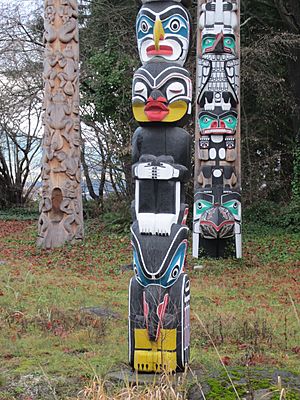Ellen Neel facts for kids

Ellen Neel (1916–1966) was a talented Kwakwaka'wakw artist who carved wood. She is known as the first woman to professionally carve totem poles. Ellen Neel came from Alert Bay, British Columbia. Her amazing artwork can be found in collections all over the world.
Before Ellen Neel started carving professionally in the late 1920s, there were no women known as carvers in history books. Ellen Neel inspired other First Nation women, like Freda Diesing (from the Haida nation) and Doreen Jensen (from the Gitksan nation), to become carvers too.
Contents
Early Life and Learning
Ellen May (née Newman) Neel had a special Potlatch name: Kakaso'las. She was born on November 14, 1916, in Alert Bay, British Columbia. Her parents came from different backgrounds, and she was a member of the Kwakwaka'wakw tribe.
Ellen learned the art of Northwest carving from her grandfather, Yakuglas/Charlie James. He was a very famous totem carver. She also learned from her uncle, the well-known sculptor Mungo Martin. While she was at St. Michael's residential school, her grandfather carefully taught her how to draw lines, old carving styles, and traditional stories. He also taught her to be dedicated to her art. Because of her grandfather's teaching and her own hard work, Ellen started selling her carvings when she was just 12 years old!
In 1938, Ellen married Ted Neel, who was a skilled metal smith. They moved to Vancouver and had seven children together. Ellen was a stay-at-home mom, but she still made a few carvings for her friends.
Things changed a lot when Ted became very ill. They needed more money because Ted could no longer fully support the family. So, they decided that Ellen's carving would become a full-time business. Ted managed the business side, while Ellen designed, carved, and painted the artworks.
Becoming a Famous Artist
The family worked hard to make enough money to live. Then, Ellen completed the Totemland Pole for the Totemland Society. This group promoted Vancouver, and the pole helped the family financially. In 1948, Ellen spoke at a meeting called the Conference on Native Indian Affairs. This helped her career grow, and she became a well-known artist.
After the conference, the Parks Board gave her a studio in Stanley Park. There, she opened her own business called Totem Art Studios.
In 1948, Ellen Neel also helped fix several old totem poles for the University of British Columbia. In 1950, she gave a 16-foot totem pole to the university in a traditional ceremony. Soon, her sons helped a lot with the carving. They made many smaller poles, from six to 18 inches tall, for tourists. These smaller poles were the family's main way to earn money. But Ellen also got to work on larger, more artistic totems. For example, in 1953, she carved a pole for a museum in Denmark.
In 1955, a large store called Woodward's Department Store asked Ellen Neel to create five totem poles for a shopping mall in Edmonton. These poles were brought back to the coast in the 1980s. Ellen's son, Robert, fixed one of them, which now stands in Stanley Park.
In 2017, Ellen Neel's art was shown in a special exhibit at the University of Victoria's Legacy Art Gallery. Her artwork called Cedar Mask was also part of the "Hearts of Our People" exhibition. This show featured Native women artists at the Minneapolis Institute of Art in 2019.
Her Children's Contributions
Ellen's children became a very important part of the family business. They learned carving skills and some, like her son David, started their own art careers. The Neels moved from Vancouver to South Burnaby, then White Rock, and finally Aldergrove, British Columbia.
As the children grew up and started their own lives, they would send money to their parents when times were tough. Their son John stayed with them and helped Ellen carve. Robert "Bob" Neel also became a skilled carver himself.
Later Life and Legacy
By 1961, Ted and Ellen were facing health challenges. In September 1961, their son Dave died in a sad event. By 1965, it became harder for Ellen to sell her art. Things were getting difficult, and Ellen Neel passed away in 1966.
Ellen Neel was very important in showing that Native arts could help Indigenous communities support themselves. Her work also helped keep their heritage alive. In 1985, the UBC Museum of Anthropology put up one of the totem poles Ellen had carved for them in Stanley Park. You can still see it there today.
The totem pole she gave to the University of British Columbia was rebuilt by master carvers and given a new dedication in 2004. There was a special ceremony led by the Kwakwaka'wakw Chief of the Heiltsuk Nation, Edwin Newman.
Ellen's grandson, David Neel, is also a talented artist today. He is a carver, jeweler, painter, photographer, and author living in British Columbia.
Exhibits
- Hearts of Our People: Native Women Artists, (2019), Minneapolis Institute of Art, Minneapolis, Minnesota, United States.
See also
 In Spanish: Ellen Neel para niños
In Spanish: Ellen Neel para niños


